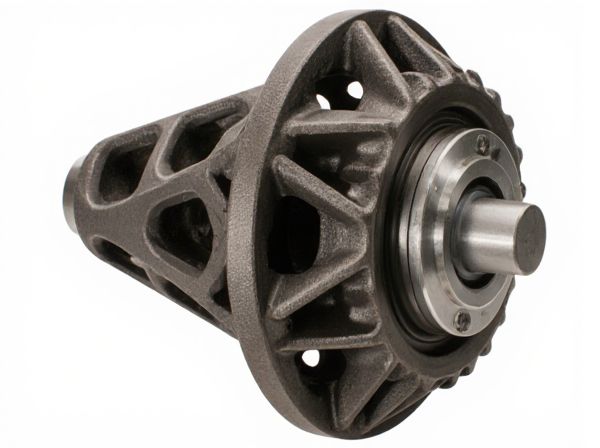
Photo illustration: Cone-type Limited Slip Differential vs Plate-type Limited Slip Differential
Cone-type limited slip differentials use conical friction elements to transfer torque between wheels, offering smooth engagement and excellent durability under high loads. Plate-type limited slip differentials rely on multiple friction plates to distribute power, providing precise control and better performance in varying traction conditions. Your choice depends on whether you prioritize robust torque handling with cone types or finer traction control with plate types.
Table of Comparison
| Feature | Cone-type Limited Slip Differential | Plate-type Limited Slip Differential |
|---|---|---|
| Design | Uses conical friction surfaces for torque transfer. | Employs multiple friction plates stacked together. |
| Torque Bias | Moderate torque bias, smooth engagement. | Higher torque bias, more aggressive locking. |
| Durability | Robust but can wear cone surfaces over time. | Durable with replaceable friction plates. |
| Maintenance | Less frequent, but repairing cones is complex. | Requires periodic plate replacement. |
| Heat Dissipation | Lower heat dissipation due to smaller friction area. | Better heat management via multiple plates. |
| Application | Common in performance and off-road vehicles. | Widely used in racing and high-torque vehicles. |
| Cost | Generally less expensive to manufacture. | Higher manufacturing and maintenance cost. |
Introduction to Limited Slip Differentials (LSDs)
Limited Slip Differentials (LSDs) enhance vehicle traction by distributing torque between wheels, minimizing wheel spin during acceleration or slippery conditions. Cone-type LSDs utilize tapered cones to create friction and transfer torque, offering smooth engagement and durability in high-performance scenarios. Plate-type LSDs employ multiple friction plates to manage torque distribution, providing precise control and adjustability suited for varied driving conditions.
What is a Cone-Type Limited Slip Differential?
A Cone-Type Limited Slip Differential (LSD) uses conical friction surfaces to transfer torque between wheels, improving traction by allowing limited slip under varying grip conditions. This design offers smooth engagement and is often favored in off-road and rally applications for its durability and predictable torque transfer. Compared to Plate-type LSDs, cone-type units typically provide more linear torque distribution with less abrupt locking characteristics, enhancing vehicle stability during cornering.
How Plate-Type Limited Slip Differentials Work
Plate-type limited slip differentials use a series of clutch plates stacked between the side gears and the differential housing, which engage and create friction when torque differences occur between the wheels. This friction transfers torque from the wheel with less traction to the wheel with more traction, improving grip and vehicle stability during cornering or slippery conditions. The amount of torque transfer depends on the clamping force applied to the clutch pack, often controlled by preload springs or hydraulic pressure.
Key Differences: Cone-Type vs Plate-Type LSDs
Cone-type limited slip differentials use conical friction surfaces to transfer torque between wheels, providing smooth engagement and gradual slip control ideal for performance driving. Plate-type LSDs rely on multiple friction plates stacked together to deliver higher torque capacity and stronger locking force, making them suitable for heavy-duty and off-road applications. Key differences include engagement smoothness, torque holding capability, and durability, with cone-type offering finer modulation and plate-type emphasizing robustness and maximum grip.
Performance Characteristics and Traction
Cone-type Limited Slip Differentials provide smooth torque transfer and excel in gradual traction adjustments, enhancing vehicle stability in moderate slip conditions. Plate-type Limited Slip Differentials generally offer quicker locking response and higher torque capacity, enabling superior traction during aggressive driving or off-road scenarios. Both systems improve cornering grip and reduce wheel slip, but plate-type units typically deliver more consistent performance under high-stress loads.
Maintenance and Longevity Comparison
Cone-type limited slip differentials require regular inspection of cone clutch surfaces for wear and frequent lubrication to prevent overheating, thereby maintaining optimal performance. Plate-type limited slip differentials tend to exhibit longer service intervals due to their stacked steel plate design, which provides better heat dissipation and reduced wear under high torque conditions. Overall, plate-type limited slip differentials often offer enhanced longevity with less frequent maintenance demands compared to cone-type units.
Noise, Vibration, and Ride Quality
Cone-type Limited Slip Differentials generate more noise and vibration due to the metal-on-metal contact within the cone surfaces, potentially impacting ride quality by producing a harsher driving experience. Plate-type Limited Slip Differentials operate with stacked friction plates, providing smoother engagement that reduces noise and vibration, thereby enhancing overall ride comfort. The choice between cone and plate types significantly influences NVH (Noise, Vibration, and Harshness) characteristics, with plate-type LSDs favored for quieter, smoother vehicle dynamics.
Applications in Motorsports and Street Vehicles
Cone-type Limited Slip Differentials (LSDs) excel in motorsports due to their rapid torque transfer and smooth engagement, providing enhanced traction during aggressive cornering and high-speed maneuvers. Plate-type LSDs, commonly utilized in street vehicles, offer more gradual torque distribution and durability under everyday driving conditions, ensuring improved handling and safety on varied road surfaces. Motorsports applications favor cone-type LSDs for their lightweight construction and responsiveness, while street vehicles benefit from plate-type LSDs' reliability and comfort.
Cost and Ease of Installation
Cone-type Limited Slip Differentials generally offer a more affordable option compared to Plate-type Limited Slip Differentials due to simpler manufacturing processes. They often feature a more straightforward installation procedure, making them popular in off-road and budget-conscious applications. Plate-type LSDs, while offering enhanced performance, usually come with higher costs and require more complex installation, often necessitating professional expertise.
Choosing the Right LSD for Your Needs
Cone-type limited slip differentials offer smooth, progressive torque transfer ideal for street driving and mild off-road conditions, providing consistent grip with less noise and wear. Plate-type limited slip differentials excel in high-torque and performance applications, delivering quicker lockup and greater durability under aggressive driving or heavy-duty use. Selecting the right LSD depends on your driving style, vehicle type, and desired balance between comfort, traction, and long-term reliability.
 caratoz.com
caratoz.com